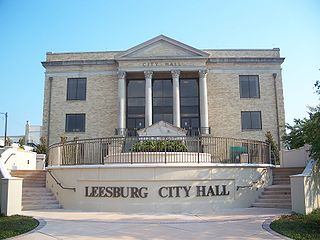
U.S. Route 1 (US 1) is a major north–south U.S. Highway that serves the East Coast of the United States. It runs 2,369 miles (3,813 km), from Key West, Florida north to Fort Kent, Maine, at the Canada–US border, making it the longest north–south road in the United States. US 1 is generally paralleled by I-95, though the former is significantly farther west (inland) between Jacksonville, Florida, and Petersburg, Virginia. The highway connects most of the major cities of the East Coast—including Miami, Jacksonville, Richmond, Washington, D.C., Baltimore, Philadelphia, New York City, Boston and Portland, passing from the Southeastern United States to New England.

The Florida East Coast Railway is a Class II railroad operating in the U.S. state of Florida, currently owned by Grupo México.

The Seaboard Air Line Railroad, which styled itself "The Route of Courteous Service," was an American railroad which existed from April 14, 1900, until July 1, 1967, when it merged with the Atlantic Coast Line Railroad, its longtime rival, to form the Seaboard Coast Line Railroad. Predecessor railroads dated from the 1830s and reorganized extensively to rebuild after the American Civil War. The company was headquartered in Norfolk, Virginia, until 1958, when its main offices were relocated to Richmond, Virginia. The Seaboard Air Line Railway Building in Norfolk's historic Freemason District still stands and has been converted into apartments.

The Atlantic Coast Line Railroad is a former U. S. Class I railroad from 1900 until 1967, when it merged with long-time rival Seaboard Air Line Railroad to form the Seaboard Coast Line Railroad. Much of the original ACL network has been part of CSX Transportation since 1986.
The Jacksonville and Atlantic Railroad Company was incorporated under the general incorporation laws of Florida for the purpose of constructing, maintaining and operating a railroad for public use in the conveyance of persons and property, from the south bank of the river St. Johns opposite the city of Jacksonville, Duval County, Florida, to a point on the Atlantic, at or near section 33, township 2, south, range 29, east. Florida state law chapter 3640, approved January 29, 1885, gave the company enlarged powers, including running boats across the St. Johns River.

The Silver Meteor is a passenger train operated by Amtrak between New York City and Miami, Florida. Introduced in 1939 as the first diesel-powered streamliner between New York and Florida, it was the flagship train of the Seaboard Air Line Railroad and its successor, the Seaboard Coast Line. It was handed to Amtrak when it took over intercity rail service in 1971.

The Silver Star is a 1,522-mile (2,449 km) passenger train route in the Silver Service brand operated by Amtrak, running from New York City south to Miami, Florida via the Northeast Corridor to Washington, D.C., then via Richmond, Virginia; Raleigh, North Carolina; Columbia, South Carolina; Savannah, Georgia; Jacksonville, Florida; Orlando, Florida; and Tampa, Florida.
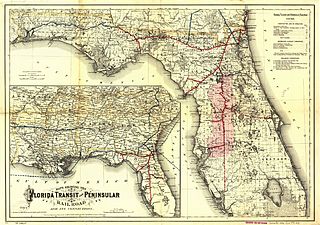
The Florida Central and Peninsular Railroad was the final name of a system of railroads throughout Florida, becoming part of the Seaboard Air Line Railway in 1900. The system, including some of the first railroads in Florida, stretched from Jacksonville west through Tallahassee and south to Tampa. Much of the FC&P network is still in service under the ownership of CSX Transportation.
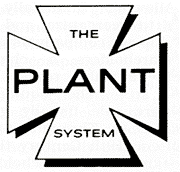
The Plant System named after its owner, Henry B. Plant, was a system of railroads and steamboats in the U.S. South, taken over by the Atlantic Coast Line Railroad in 1902. The original line of the system was the Savannah, Florida and Western Railway, running across southern Georgia. The Plant Investment Company was formed in 1882 to lease and buy other railroads and expand the system. Other major lines incorporated into the system include the Savannah and Charleston Railroad and the Brunswick and Western Railroad.
Byron Kilbourn was an American surveyor, railroad executive, and politician who was an important figure in the founding of Milwaukee, Wisconsin.
State Road 44 is an east–west state highway in the U.S. state of Florida. It runs from Crystal River on the Gulf of Mexico east to New Smyrna Beach on the Atlantic Ocean, passing through Inverness, Wildwood, Leesburg and DeLand.
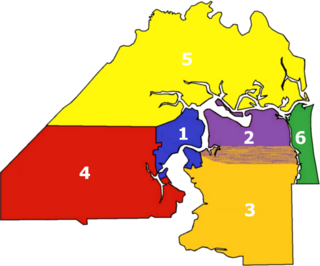
There are more than 500 neighborhoods within the area of Jacksonville, Florida, the largest city in the contiguous United States by area. These include Downtown Jacksonville and surrounding neighborhoods. Additionally, greater Jacksonville is traditionally divided into several major sections with amorphous boundaries: Northside, Westside, Southside, and Arlington, as well as the Jacksonville Beaches.
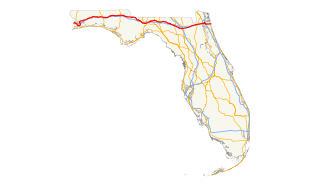
U.S. Route 90 in the State of Florida is the northernmost west-to-east U.S. route in the state although it is one of the southernmost U.S. west-to-east routes in the rest of the United States. Highway 90 passes through the county seats of all 15 counties on its course in Florida, and is also the road upon which many of the county courthouses are located. It is never more than six miles (10 km) from I-10 throughout the state. It runs as a two-lane highway through most of the sparsely populated inland areas of the panhandle, becoming four-lanes through and near several towns. The speed limit is 55 mph (89 km/h) for all rural points west of Monticello, and it is 60 mph (97 km/h) on all rural points beginning in Madison County to Glen St. Mary.

The Champion was a streamlined passenger train operated by the Atlantic Coast Line Railroad and Florida East Coast Railway between New York City and Miami or St. Petersburg, Florida. It operated from 1939 until 1979, continuing under the Seaboard Coast Line and Amtrak. It was a direct competitor to the Seaboard Air Line Railway's Silver Meteor, the first New York-Florida streamliner.
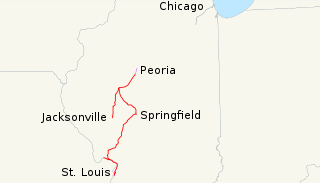
The Chicago, Peoria and St. Louis Railroad (CP&StL) was a railroad in the U.S. state of Illinois that operated a main line between Pekin and Madison via Springfield. Its property was sold at foreclosure to several new companies in the 1920s; the portion north of Springfield has since become the Illinois and Midland Railroad, while the remainder has been abandoned, except for a portion near St. Louis that is now owned by the Norfolk Southern Railway.

Interurban and streetcar railways flourished in Syracuse, New York until the automobile, airplane and bus took their place.
The Fifth Ward Railroad was a horse-drawn street trolley line in Syracuse, New York, and was originally approved for construction by New York State in 1850; however, the rail was not chartered until 1867 and finally opened for business in 1868. The company merged with Syracuse Consolidated Street Railway in 1890, after an agreement was made that allowed the new company to lease the lines.
The following is a timeline of the history of the city of Jacksonville, Florida, USA.
